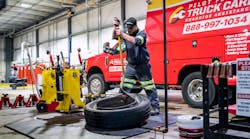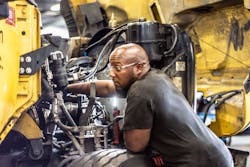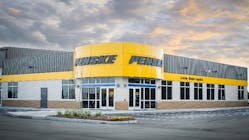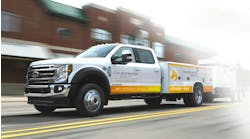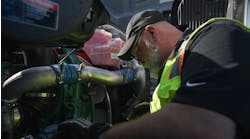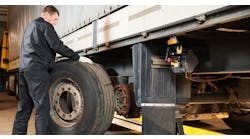Uptime is critical in the trucking industry, meaning fleets need to ensure their trucks are on the road as much as possible. For those running long haul routes across the country, it is important to work with a service provider that offers locations wherever their trucks may be, or at least along their most commonly traveled routes.
The ability to schedule preventive maintenance virtually anywhere – and the fact that a truck is never far from a repair facility in case of a breakdown – helps mitigate unnecessary downtime and provides fleets with peace of mind.
“With long haul fleets, downtime becomes very expensive very quickly,” says Anita M. Byrne, director of business development for HDA Truck Pride, an independent provider of parts and service to the commercial vehicle aftermarket. “Missed delivery windows, loss of load [such as] frozen foods and perishables, missed return loads ... It is imperative to have consistent, reliable service available 24/7/365 anywhere the fleet operates.”
When it comes to choosing what service network (or networks) to partner with, fleets should weigh their options carefully. If the fleet runs a certain route on a regular basis, it will behoove them to work with a service network offering multiple locations along that route. On the other hand, if a fleet’s routes vary and their trucks are likely to be in any corner of the country at a given time, a service network with the most widespread locations would be more appropriate.
Other considerations, such as OE warranty coverage, also come into play. A fleet with mostly newer vehicles will want to utilize the OE dealer network rather than an independent, third-party network in order to take advantage of warranty coverage.
OE networks
In addition to offering warranty coverage, OE networks also provide technicians who are specifically trained to service the makes and models sold by that brand. This can mean faster and higher quality service and repairs.
“Trucks are more complex than ever with a number of systems that are interdependent from one another,” says Admir Kreso, general manager of dealer service for commercial vehicle manufacturer Daimler Trucks North America (DTNA). “Our shops have all of the background and history of our products that they service along with the expert, trained technicians to ensure that the vehicle is fixed right the first time.”
OE dealer networks also typically have greater access to OE resources for troubleshooting as well as parts and components through the manufacturer and the dealer network, Kreso confirms.
One advantage to using OE parts and components even after the vehicle itself is outside of warranty is that many parts are covered by their own warranty after a repair.“Repairs are backed by the network, so should a part fail after being installed at one of these locations, another dealer in the network can handle the warranty that comes with that part,” says John Crichton, field service director for Navistar, the manufacturer of International brand trucks and diesel engines.
This provides a major advantage to fleets looking to cut down on unnecessary costs.
Independent networks
Fleets that use vehicles from a variety of manufacturers, or those with many vehicles outside of warranty, may consider working with an independent third-party network. While OE networks specialize in their own brand of vehicles, independent networks may be more well-versed in servicing a variety of makes and models.
“In the real world, long-haul fleets are typically mixed fleets, with vehicles of various make, model, and age,” says HDA Truck Pride’s Byrne. “Independent service providers offer expertise across this spectrum because of their experience with the diverse customer. This independent provider can also typically work on both tractor and trailer.”
The ability for an independent network to service trailers as well as tractors may seem minor, but it can make a major difference when facing downtime due to an issue with a trailer.
While OE networks have the benefit of offering warranty service, working with an independent network does not necessarily leave a fleet without warranty options. Some independent networks are certified to perform warranty work for certain OE vehicles.
“With the addition of Love’s Truck Care and Speedco as an International Truck warranty provider, we have bridged the gap between [OE and independent] networks,” says Eric Daniels, director of tire care operations for Love’s Truck Care, a network of service centers providing heavy duty tire care, light mechanical services, and roadside assistance.
Drew Kortyna, vice president of TA Truck Service for TravelCenters of America, a full-service travel center company operating full service centers, confirms that Freightliner and Western Star warranty service is offered at most TA Truck Service locations as well.
Lease networks
Somewhere in between OE and independent service networks, lease networks are for fleets that choose to lease vehicles rather than purchase them.
Mike Hasinec is vice president of maintenance for Penske Truck Leasing, a provider of full-service commercial truck leasing, truck fleet maintenance, truck rentals, and used truck sales. Hasinec relates that one advantage to lease networks is receiving priority service at virtually any service location, even without an appointment. A vehicle experiencing difficulties that takes the truck down while away from its home base could stop at the nearest Penske location and be prioritized above local vehicles in for non-emergency service.
“For example, if ... you're domiciled in Reading, Pennsylvania, and you're traveling to California and you need something done to your vehicle, you can stop at any facility in between [and] we're going to work on it,” Hasinec explains. “You don't necessarily need to schedule an appointment. Especially if it's safety related or mission critical, once your vehicle shows up at that facility, we're going to prioritize that and get that vehicle back up and running on the road.”Penske also maintains relationships with many major truck OEs, which allows the truck leasing company to perform warranty work as well.
“We perform our own warranty work for Daimler, Navistar, Volvo, Hino, Isuzu, et cetera, inside our facilities,” Hasinec says. “And, we have our own internal warranty department who then has the capability to file warranty [claims] with the OEM, just like a dealer.”
Hasinec notes that Penske service centers will take on virtually any type of maintenance or service, but typically outsource major projects such as engine overhauls to engine or vehicle manufacturers.
“Other than that, if it comes in the door, we're going to work on it,” Hasinec says.
Services offered
OEs are traditionally known for taking on larger service items such as engine overhauls, while independent networks are known for their quick work on smaller tasks as well as roadside service. In recent years, both network types have begun to offer a wider variety of services to bridge that gap, but offerings still vary.
OE services
While warranty work and larger overhauls are the trademark of OE service networks, many are beginning to see the benefit of more readily providing less labor intensive services. Some OEs are doing this by providing triage when a vehicle first arrives at the service center to determine how long repairs will take.
According to Todd Shakespeare, director of parts marketing for commercial vehicle manufacturer Volvo Trucks North America, Volvo service centers categorize and split repairs between long and short. Based on the company’s research, the majority of jobs can be considered short. Short jobs are placed into a subset of bays in the shop called an Uptime Bay, and the work is completed as soon as possible to free up time for technicians to focus on longer, more involved jobs.
DTNA’s Kreso confirms Daimler dealers handle repairs in a similar manner.
“Every vehicle entering the dealership is placed in DTNA’s Express Assessment process and receives rapid diagnosis of the problem,” Kreso explains. “Today, 40 to 50 percent of the repairs in our network are zero to four hours in labor hours. These are Express Repairs and are diagnosed and fixed by the same technician to provide the expedient fleet/customer service experience. Longer hour repairs require staging and, in most cases, are scheduled into long hour repair bays.”
Cory Just, field service director for Navistar, notes that the company uses a similar triage process called Accelerated Service Lane, which also provides a two-hour communication window to the fleet during an unplanned downtime event. This communication provides the fleet with important information on what next steps are needed for the cargo they are transporting: whether they can wait, or if they need to send a replacement vehicle.
Commercial vehicle manufacturer Kenworth also uses a similar two-hour diagnostic process at Kenworth PemierCare Gold Certified dealers, according to company spokesman Jeff Parietti. These dealers offer ExpressLane service and extended evening and weekend hours to help expedite vehicle service.
Independent services
Jon Salter, director of shop operations for Pilot Flying J Truck Care, a network of commercial vehicle service centers, says Pilot offers mainly quick services.
“Our Service Centers offer standard truck services, preventive maintenance, trailer washouts, alignments, inspections, vehicle diagnostics, jump starts, repairs, electrical, lube services, retail and National Account sales, and 24/7 emergency roadside service,” Salter says.
Love’s Truck Care’s Daniels and TA Truck Service’s Kortyna both confirm their respective companies offer similar level services, both including tire sales, service, and retreads, as well as roadside assistance.
Some HDA Truck Pride locations, however, offer higher level services similar to OEs.
“Depending on the location, HDA Truck Pride affiliated service centers provide a full array of services from oil changes to complete engine overhauls,” says HDA Truck Pride’s Byrne. “Generally speaking, any service the fleet needs, HDA Truck Pride can help find the solution.”
With a variety of services now offered by both OE and independent service networks, fleets are afforded more options when it comes to selecting the network that best suits their needs.
Telematics integration
Part of completing vehicle service in an expedient manner is taking advantage of all available technologies. Two newer technologies that can significantly reduce service and repair times are remote diagnostics and telematics.
Computers onboard the truck predict when maintenance will be due or detect when there is an issue with a vehicle system. The necessary information is communicated to the OE who can then work together with the fleet to find the nearest service location, make an appointment or notify the shop that the vehicle is en route, and ensure the necessary parts and components are on-hand to complete the repair.Company representatives confirm that Daimler’s Virtual Technician, Kenworth’s TruckTech+, Navistar’s International 360 and OnCommand Connection, and Volvo’s Remote Diagnostics (connected to the company’s ASIST platform) all provide similar functions.
Independent networks also utilize telematics data to increase service efficiency. However, gaining access to OE telematics information is somewhat more complicated since vehicle manufacturers are not currently under any obligation to provide that information to independent service networks.
Many fleets choose to use third-party telematics solutions, which allows them to receive telematics data directly without going through the OE. This also means the fleet can allow independent service networks to receive their telematics data.
“We use the data that the vehicle provides us, but there's a lot of segmentation that takes place,” Penske’s Hasinec says. “Whatever the vehicle can tell us that doesn't have to go through the customer's telematics, we get.”
Hasinec adds that if the fleet provides permission for Penske to receive telematics data, they can receive all necessary information.
HDA Truck Pride’s Byrne confirms their network also offers integration with third-party telematics systems.
“HDA Truck Pride offers its service provider network a choice of telematics platforms for easy communication of predictive, preventive, and incident-related maintenance,” Byrne says.
TA Truck Service’s Kortyna notes that TA is currently developing a telematics solution, and Love’s Shop Connect portal allows fleets to manage estimates, repairs, and communication with any Love’s locations nationwide, Love’s Truck Care’s Daniels says.
Finding the nearest or most convenient location for a driver or fleet is also made easy thanks to today’s technologies. OEs and independent networks alike all offer location finder tools on their respective websites or apps.
Sourcing parts and components
Once a service center has been notified or the truck arrives in the triage bay, the next step is ensuring the proper parts and components are available. Many service centers use complex algorithms to keep enough stock of commonly used parts on hand. While all service centers monitor what parts are most frequently purchased, OE networks tend to differ from independent networks in a few ways.
A major consideration is that OEs only need to stock parts for their own brand, while independent service centers have to consider a myriad of vehicle years, makes, and models. While that does simplify the stocking process for OE service networks, it also means the source for parts is much narrower; they come from the OEs themselves in the form of both OE brand parts and (in most cases) private label parts.
On the other hand, independent service centers tend to stock both OE and aftermarket parts, allowing for a wider range of parts suppliers.“Unlike most dealerships that only stock parts for their particular brand, our network strives to offer the most common parts for the majority of vehicles that come through our bays for service,” says TA Truck Service’s Kortyna. “We rely on our OEM and vendor partners to help us identify the parts we need to stock. We also complete ongoing research to determine what parts we should be buying that we don’t already stock; if it makes sense to add the item, we do.”
Both OE and independent service networks have become extremely efficient at knowing what parts and how many to have in stock. And, in a case where a needed part is not in stock, most service networks are backed by a robust parts network and can have the parts available within 12 to 24 hours.
Highly trained technicians
Perhaps the most important consideration of any service network is the technicians performing the service. Having properly trained technicians is imperative to completing service in a timely manner and doing it correctly the first time.
This is another area where OE and independent service networks differ. OE technicians need to be trained specifically on their brand’s vehicles so that they are familiar with the vehicle architecture and can provide fast, accurate service.
Technicians at independent service centers need to be familiar with many makes and models. This can create added challenges to providing training in one specific area, so technicians typically specialize in different areas.
Most OE service networks require technicians to earn certification from the OE through a combination of in-house hands-on training and web-based distance learning.
Independent networks tend to vary a bit more, with some requiring certification from their own brand and others requiring industry certifications.
Pilot’s Salter, for example, says Pilot Flying J Truck Care facilities are staffed with ASE and TIA certified technicians. Penske’s Hasinec, on the other hand, says Penske uses a certification program they developed in-house.
“We have a certification program that allows the technician to progress through their career, going from a Level 3, to a [Level] 2, to a [Level] 1 technician, [Level] 1 being the person that can do it all,” Hasinec says.
Whatever the method, these training programs have one factor in common: technicians are trained continuously, at least annually and often more frequently. OE and independent service networks alike recognize the importance of keeping technicians’ knowledge up to date with the latest tools, products, and technologies to provide fleets with high quality, efficient service that keeps their vehicles on the road.
